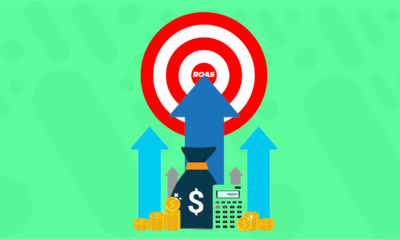Me: “In short, automated bidding is where Google automatically does the bidding for you.”
You: “What?! That’s amazing captain obvious! Just brilliant. Definitely worthy of a tweet.”
Me: “Ok fine, let’s break it down a bit further than that.
“Just come up with your campaign goals, pick the automated bidding strategy you want to use and voila! Bidding is all set and you let Google take it from there.”
You: “Really, dude?”
Me: “Ok, for reals. Let’s really dig into this now.”
What is Google doing when you choose an automated bid strategy? Google is using algorithms to automatically make bid adjustments in real time in order to achieve your bidding goals. Over the course of time, more data will be accumulated (clicks, impressions, conversions, etc). Google will use this new data to refine its bidding and, in theory, become even smarter. This is a type of machine learning. Google can learn more with increased data and make better bidding decisions. In theory.
Here’s an explanation from Simon Balfe:
“What we have done is, we apply our machine learning to our bidding platform so you can actually say to Google, I can afford to spend £5 for every lead or £7 for every sale that comes through.
“And, what Google’s machine learning can do is, look at 17 million signals every time somebody types in a search query and will use all that detail to see how likely somebody is to take that action.”
Simon Balfe, agency development manager at Google Marketing Solutions in Dublin.
If you stop and think about how many searches people perform on Google across the world in any give second, that is some extremely fast computing power.
Google Ads Automated Bidding Types
Below are the six different automated bid strategies you can use with Google Ads. Each one is designed with a specific goal in mind.
| GOAL | AUTOMATED BID STRATEGY |
|---|---|
| Increase Site Visits | Maximize Clicks – The goal is to get as many clicks as possible within your given budget. This automated bid strategy can be used in a single campaign or in a portfolio bid strategy across multiple capaigns. Learn more about Maximize Clicks. Learn more about Maximize Clicks for Shopping campaigns. |
| Increase Visibility | Target Impression Share – The goal is to show your ad in one of three ad postions; 1) the absolute top of the page (ad position 1), 2) on the top of the page (top group of ads), or 3) anywhere on the page of Google search results. This bid strategy is available only on the Search network; not available on the Display network. Learn more about Target Impression Share. |
| Get More Conversions At A Target Cost Per Acquisition (CPA) | Target CPA – The goal is to help you get as many conversions (leads or sales, for example) as possible at your desired target cost-per-action (CPA). You set the target CPA and Google automatically does the bidding for you. Target CPA bidding is available for both the Search and Display networks. Learn more about Target CPA. |
| Get Sales At A Target Return On Ad Spend (ROAS) | Target ROAS – The goal is to help you get as much conversion value as possible at your desired target return on ad spend (ROAS). This bid strategy can be effective for eCommerce businesses. Learn more about Target ROAS. Learn more about Target ROAS for Shopping campaigns. |
| Get More Conversions While Spending Your Budget | Maximize Conversions – The goal is to help you get the most conversions for your campaign while spending your budget. Learn more about Maximize Conversions. |
| Get More Conversions Value While Spending Your Budget | Maximize Conversion Value – the goal is to automatically sets bids to help you get the most conversion value for your campaign while spending your budget. Learn more about Maximize Conversion Value. |
The general idea behind automated bidding is to be more efficient with your time. Bidding can be one of the more labor-intensive tasks when it comes to Google Ads management. One way to win back those hours is to hand over the bidding keys to Google. Initially, that may sound like a smart decision and a bit of a no-brainer. However, the devil is in the details. And, for those of us who have been managing Google Ads professionally, we know the drawbacks of giving Google more power over your account. Let’s do the whole pros and cons thing.
Automated Bidding Pros
- Saves you time. Obviously, if you can hand over the bid management to a machine-learning algorithm, then you can spend that time doing something else to improve your Google Ads campaign. Opportunity cost at play.
- Leverage Google’s data. Google gets data from Google Search, Youtube, Android, Chrome, Google Analytics, Gmail, Google Ads & other properties. The 17 million signals Google can analyze for every search query, comes from this massive amount of data. That is a massive amount of digi-food being fed to the Google smart-learning machine.
- Real time bidding. Every single time someone performs a search, Google can look at those 17 million signals to come up with a specific bid for that specific search. This is done everytime your ad is served.
Automated Bidding Cons
- Lack of transparency. Google does not show you any bid changes and you have no insight into the bid changes. If results are not to your liking (leads drop, cost per lead goes up, ROI drops, etc.) there is nothing to analyze in order to see where improvements can be made.
- Lack of control. Obviously, you’ve handed the keys over to Google. You can provide a simple target metric like a target CPA or target ROAS but that’s about it.
- Google doesn’t know your business. With automated bidding, Google relies on historical data to make bid adjustments. But, your ever-evolving business is more than historical data. For example, a business may adjust staffing for different hours of the day or days of the week. Google can only react to how those efforts impact data and performance over time, which can be too late. In these cases, businesses relenquish the ability to quickly make the necessary bid adjustments to address the impact of these changes.
- Broad data use. Google’s ability to harness large swaths of data may not jive with your smaller, more unique target audience.
So, Should You Use Automated Bidding Or Not?
My advice would be to test it out and let the data inform your decision. There are a few different ways ad managers do A/B testing (or, split testing). One method I recommend trying out is to setup an experiment within Google Ads. You can set it up from within your Google Ads dashboard. With these experiments you can split test different ads or various bid optimizations.
For example, you could test a current campaign that uses manual bidding against an experiment that uses target cpa bidding. You can send 50% of that campaign’s traffic to the manual bidding campaign (control group), and 50% of the traffic to a new experiment campaign that is testing out the target cpa bidding. Google will track the experiment data and provide you with a confidence level as enough data is accumulated. This allows you to more easily determine a winner or loser in what you are testing.
Here’s a couple of resources that can help you set up an experiment. https://www.youtube.com/watch?v=w3iDO2d09qw and https://support.google.com/google-ads/answer/6261395?hl=en




